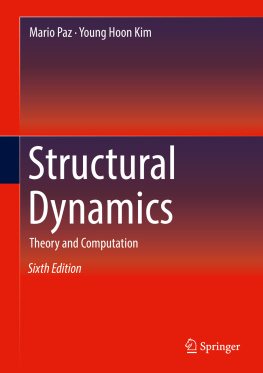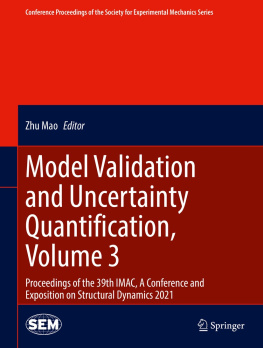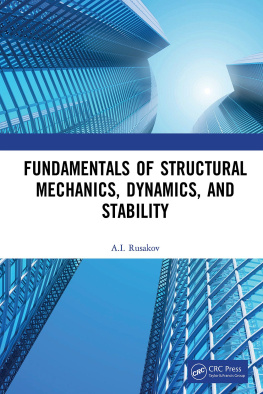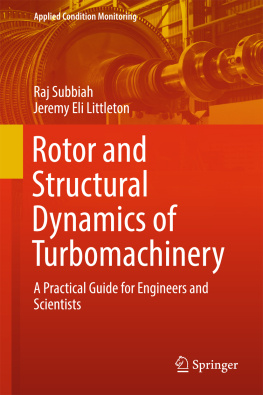Mario Paz - Structural Dynamics
Here you can read online Mario Paz - Structural Dynamics full text of the book (entire story) in english for free. Download pdf and epub, get meaning, cover and reviews about this ebook. year: 0, publisher: Springer International Publishing, genre: Children. Description of the work, (preface) as well as reviews are available. Best literature library LitArk.com created for fans of good reading and offers a wide selection of genres:
Romance novel
Science fiction
Adventure
Detective
Science
History
Home and family
Prose
Art
Politics
Computer
Non-fiction
Religion
Business
Children
Humor
Choose a favorite category and find really read worthwhile books. Enjoy immersion in the world of imagination, feel the emotions of the characters or learn something new for yourself, make an fascinating discovery.
- Book:Structural Dynamics
- Author:
- Publisher:Springer International Publishing
- Genre:
- Year:0
- Rating:5 / 5
- Favourites:Add to favourites
- Your mark:
- 100
- 1
- 2
- 3
- 4
- 5
Structural Dynamics: summary, description and annotation
We offer to read an annotation, description, summary or preface (depends on what the author of the book "Structural Dynamics" wrote himself). If you haven't found the necessary information about the book — write in the comments, we will try to find it.
Structural Dynamics — read online for free the complete book (whole text) full work
Below is the text of the book, divided by pages. System saving the place of the last page read, allows you to conveniently read the book "Structural Dynamics" online for free, without having to search again every time where you left off. Put a bookmark, and you can go to the page where you finished reading at any time.
Font size:
Interval:
Bookmark:


This Springer imprint is published by the registered company Springer Nature Switzerland AG
The registered company address is: Gewerbestrasse 11, 6330 Cham, Switzerland
The basic structure of the five previous editions is still maintained in this Sixth Edition. After the release of the Fifth Edition in 2004, academic and industrial environments have been changed, although the fundamentals have not changed over 15 years. When the author started to teach structural dynamics since 2011, the most challenging part as an instructor has been to present how students can solve and simulate the structural dynamics using the computer program. There is a limited information available to show how we can solve structural dynamics in finite element methodbased commercial software. When understanding the background of undergraduate and graduate students who are first exposed to structural dynamics, the fundamentals are mainly considered as core content. The author believes that a line-by-line computer language is a helpful learning and teaching tool for its application of fundamentals. This is the major motivation of the revision of this textbook.
This revised textbook intends to provide enhanced learning materials for students to learn structural dynamics, ranging from basics to advanced topics, including their application. When a line-by-line programming language is included with solved problems, students can learn course materials easily and visualize the solved problems using a program. Among several programming languages, MATLAB has been adopted by many academic institutions across several disciplines. Many educators and students in the USA and many international institutions can readily access MATLAB , which has an appropriate programming language to solve and simulate problems in the textbook. It effectively allows matrix manipulations and plotting of data. Therefore, multi-degree-of-freedom problems can be solved in conjunction with the finite element method using MATLAB . As of 2018, SAP2000 presented in the Fifth Edition is currently outdated, at least regarding user interface procedure. The revision author Young Hoon Kim still believes that SAP2000 includes routines for the analysis and design of structures with linear or nonlinear behavior subjected to static or dynamics loads. However, in this edition exclusion of SAP2000 is necessary to minimize the learners confusion to link between contents and solving with the aid of computer programming language. The author still believes that SAP2000 can be one of the best tools to solve structural analysis and structural dynamics in complex systems. Practical engineers who are eager to use commercial software can learn from many other textbooks available in the market. Generously, authors offer the alternative option to navigate other textbooks related to finite element methods. In short, the Sixth Edition mainly targets readers such as senior or master students in structural engineering and earthquake engineering in civil engineering.
Printed code language helps students to understand the application of structural dynamics.
Graduate students are able to apply the fundamentals to real design problems using current version and practices.
Enhanced illustrations will enhance the readability of expected readers.
I also like to take this opportunity to thank my colleagues in my home department at Speed School of Engineering at the University of Louisville, KY, especially, Dr. J.P. Mohsen, who continuously encouraged me to revise this book in a timely manner. He recommended the Fifth Edition which also originated from the Third Edition, which I first read in my undergraduate structural dynamics study in South Korea. I also wish to recognize and thank my current PhD student, Jice Zeng. He did diligent work redrawing most figures from the previous edition of this textbook. Especially, I want to thank Dr. Yeesock Kim at California Baptist University. He introduced the application of programming language in my first course of structural dynamics at the University of Louisville which enabled me to proficiently apply structural dynamics using MATLAB . Finally, I was able to transform my course materials into part of the revision of this version. In addition, I wish to thank Paul Drougas and Flanagan Caroline who patiently waited for my final manuscript.
Font size:
Interval:
Bookmark:
Similar books «Structural Dynamics»
Look at similar books to Structural Dynamics. We have selected literature similar in name and meaning in the hope of providing readers with more options to find new, interesting, not yet read works.
Discussion, reviews of the book Structural Dynamics and just readers' own opinions. Leave your comments, write what you think about the work, its meaning or the main characters. Specify what exactly you liked and what you didn't like, and why you think so.










![Mario Vargas Llosa [Mario Vargas Llosa] - Captain Pantoja and the Special Service](/uploads/posts/book/142220/thumbs/mario-vargas-llosa-mario-vargas-llosa-captain.jpg)
